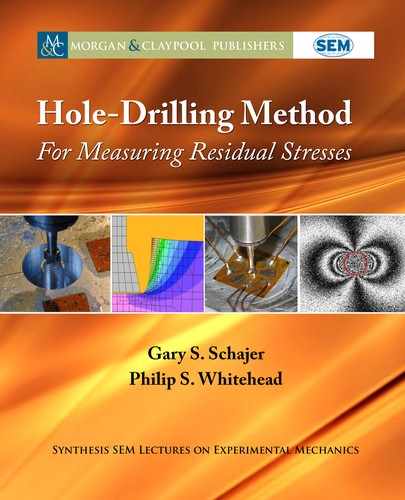
70 4. STRAIN GAUGE TECHNIQUE: METHOD DESCRIPTION
4.1 STRAIN GAUGE ROSETTE SELECTION
Hole-drilling rosettes typically contain three radial strain gauges arranged in rectangular for-
mat (
0
ı
–
90
ı
–
225
ı
or
0
ı
–
45
ı
–
90
ı
) to produce three in-plane relieved strain components for the
computation of the three stress components
x
,
y
, and
xy
. ASTM E837 describes the use
of three different rosette types to suit a range of measurement needs. Figure 4.1 illustrates the
three rosette geometries. e most widely used rosettes are Type A and Type B, each contain-
ing three radial gauge elements, large solder pads and center-line alignment markers. Type A,
which follows the geometry described by Rendler and Vigness (1966), is a general-purpose de-
sign appropriate for most measurement needs. Type B has all three strain gauges placed on the
same side of the hole location and is useful for making measurements adjacent to obstacles or
boundaries.
Type A Type B Type C
Figure 4.1: Standardized hole-drilling strain gauge rosettes (reproduced by permission of Micro-
Measurements, a Vishay Precision Group brand).
Type A rosettes are available in three geometrically similar sizes to suit holes of nominal
diameters 1/32”, 1/16”, and 1/8”. eir layouts are identical, with all dimensions varying by a
factor of 2 from one size to the next. In practice, the drilled hole diameters commonly used are
larger than the nominal sizes, typically about 1 mm, 2 mm, and 4 mm, respectively. Typical hole
depths equal half the drilled hole diameter. Type B rosettes are commercially available only in
the 1/16” nominal size.
e Type C rosette is a specialized design suited to measurement of small residual stresses
and to measurements on materials with low thermal conductivity such as plastics. e de-
sign comprises three radial strain gauges and three circumferential gauges, connected in three
half-bridge circuits. is arrangement increases the effective strain sensitivity of the rosette
and also provides compensation for thermal strains, both very useful features when measuring
small strains. e thermal strain compensation also greatly stabilizes measurements on low-
conductivity materials that do not provide adequate heat dissipation for strain gauges when
connected within quarter-bridges. In general, this rosette pattern should be used only for these
purposes because the half-bridges are costly and time consuming to assemble.
..................Content has been hidden....................
You can't read the all page of ebook, please click here login for view all page.
